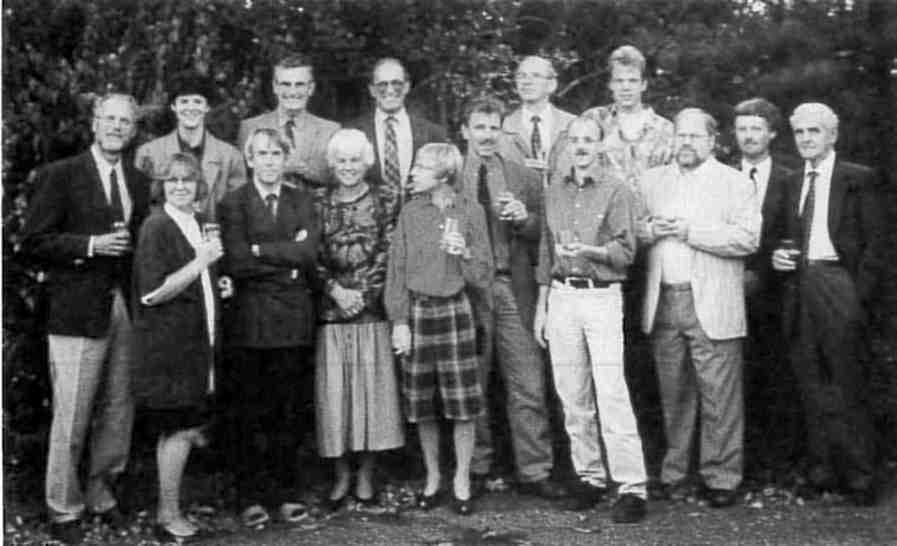


Meeting report
Strong Opinions about Weak Interactions
A workshop on Weak Directional Interactions, organized by J. Kroon and L. Kroon-Batenburg at the Bijvoet Center of Biomolecular Research (Utrecht U.) in September 1995, featured a multidisciplinary discussion of the nature of weak interactions, important in the structure of crystals and macromolecules. C-H···O interactions were the principal focus of the discussion but C-H···B (B=N, acetylene, pi, aromatic rings, etc.) interactions also received attention.
J. Kroon (Utrecht) opened the workshop with the provocative question: "Is crystal packing determined by C-H···O hydrogen bonds, or are C-H···O contacts determined by crystal packing?" F. Van Duijneveldt (Utrecht) presented an exposition of the ab initio molecular orbital treatment of C-H···O bonds. He discussed the partitioning of the energy involved into its components.
G. Jeffrey (Pittsburgh) pointed out that with forced contact C-H···O interactions, the exchange repulsion term may be greater than the electrostatic attractive term at short H···O distances. Short C-H···O distances may not make bonding contributions to the cohesive energy, especially if the C-H···O angle is far from 180°. The concept that short H···O distances may correspond to repulsive forces while the longer distances are attractive is a novel one. The calculated H3CH···OH2 potential is very flat. A flat potential surface over a range of distances implies both a sensitivity to structural features beyond the C-H···O bond and a very minor influence on molecular conformation or molecular packing.
A survey lecture on C-H···B hydrogen bonds in crystals was given by Th. Steiner (Berlin). He included an historical account, going back to Glasstone in 1937 and Donohue's 1968 dismissal of the existence of the C-H···O hydrogen bond. He discussed chemical variety, geometry, patterns, database studies and examples of noteworthy structures and structural patterns and included the general features of C-H···N hydrogen bonds.
R. Hooft (Heidelberg) presented the statistical analyses of C-H···O interactions, involving a great variety of functional groups taken from the Cambridge Structural Database (CSD). Steiner studied the geometries of C-H···O contacts, using a limited data set. He applied a cut-off criterion, and found that C-H···O interactions have statistical distributions resembling those of conventional H bonds.
Hooft, on the other hand, using only contacts involving closest neighbors, tries to establish if, or when C-H···O bonds are observed. He compared O···O and C···O distances in the absence and presence of hydrogens covalently bonded to the carbon or oxygen atoms. With O-H···O interactions, he generally observed an O···O shortening, but for C-H···O this trend was not manifest.
E. Lutz and J. van der Maas (Utrecht) reviewed the vibrational spectroscopic criteria for hydrogen bonding applicable in crystals, liquids, solutions and gas phase systems. They pointed out that for A-H··· B, the formation of a hydrogen bond leads to a lowering of the frequency, and an increase of both intensity and bandwidth for an A-H stretching vibration, while the A-H bending vibration shows an increase in frequency upon the formation of a hydrogen bond. Concurrently, the stretching vibration of the acceptor shows a lowering of the frequency.
J. Bernstein (Beer Sheva) suggested that the presence of particular patterns in crystal structures can be a useful criterion for identifying hydrogen bonds and other interactions. Such an approach utilizes structural data and chemical intuition. The use of graph sets to characterize the patterns of hydrogen bond networks were presented. Graph set classification shows features which persist among a large number of different hydrogen-bonded crystal structures.
 Tired of drinking indoors, the participants at the H-Bond conference take to the woods.
Tired of drinking indoors, the participants at the H-Bond conference take to the woods.
Investigators differed with respect to the criteria that define a hydrogen bond. L. Kroon-Batenburg (Utrecht) compiled the following list of these criteria.
- An H···B distance is shorter than the sum of the van der Waals radii. (Unfortunately there is no general agreement on what radii to use.)
- A-H···B hydrogen bonds play a role in determining the 3D-structure.
- Hydrogen bonds form well-defined patterns.
- A-H···B interactions occur more frequently than would be expected on the basis of the stoichiometry of the crystals and statistical analysis.
- Hydrogen bonds have directional interactions.
- The IR stretch frequency of A-H will change with the formation of a hydrogen bond. This is the main spectroscopic parameter used to identify hydrogen bond formation.
- The first order interaction energy (electrostatics and exchange repulsion) gives a characteristic Morse potential shape to the potential energy curve of a complex.
- The second order interaction energy (induction and charge-transfer) is responsible for lengthening the covalent A-H bond.
- Cooperative interactions are observed such as polarization enhancement and resonance enhancement, i.e. RAHB, Resonance Assisted Hydrogen Bonds.
It was evident from the lively discussion that forums such as this can be useful for defining and debating basic concepts. Because structure is intimately related to properties, crystallographers have a crucial role to play in such discussions. This is especially true of weaker interactions that influence supramolecular chemistry, self-assembly, and molecular recognition, areas of increasing interest to chemists and molecular biologists.
J. Kroon

